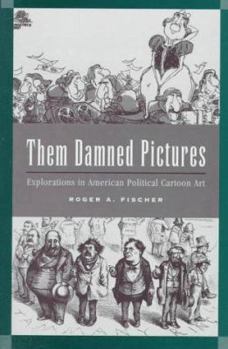Them Damned Pictures: Explorations in American Political Cartoon Art
Fischer (history U. of Minnesota-Duluth) surveys the art and power of political cartoons in the US through the 19th and 20th centuries. He demonstrates the freedom with which cartoonists portrayed... This description may be from another edition of this product.
Format:Hardcover
Language:English
ISBN:0208022988
ISBN13:9780208022981
Release Date:January 1995
Publisher:Archon Books
Length:253 Pages
Weight:1.25 lbs.
Dimensions:1.0" x 6.3" x 9.3"
Customer Reviews
1 rating
A history of political cartoonists and the power they had
Published by Thriftbooks.com User , 20 years ago
With the advent of radio and television, the power of the print media to alter public opinion has been reduced. It is difficult for people of the late twentieth and early twenty-first centuries to understand the power of the print media before radio became a mass media. Furthermore, with the heavier regulation of the media in modern times, we do not appreciate how wild and unprincipled the print media was. There were no rules for honesty and outside the limits of profanity and pornography, there were few restrictions on good taste. Finally, universal literacy in English is a very recent phenomenon, so the picture was an extremely powerful literary mechanism. The title of the book comes from the supposed statement made by Boss Tweed, "Stop the damned pictures, I don't care so much what the papers say about me. My constituents can't read. But, damn it, they can see pictures!" It was a response to political cartoons by Thomas Nast, exposing the corruption in New York led by Tweed. He was ultimately removed and died in prison as a pauper. This book is a recapitulation of political cartoonists, described by one of their own as a group that, "would be hired assassins if they didn't draw for a living." While they do not have the power they had before electronic media, political cartoonists can still sway many people. The emphasis is on some of the most significant figures in cartooning and the subjects of their cartoons. The legacy of Abraham Lincoln is used to contrast many of the actions of recent presidents and of course Richard Nixon is the subject of most of a chapter. A great deal of ink is spent in describing how racial and ethnic prejudice was expressed in editorial cartoons. Jews, Indians and blacks were systematically ridiculed in cartoons, although other ethnic groups such as the Irish were not spared. One of the most absurd arguments was that the anti-Semitism expressed in American society was not all that serious, especially when compared to that taking place in Europe. All aspects of American society were exposed in political cartoons, so this book is also a history lesson. I enjoyed the book immensely. It is a demonstration of one segment of our society whose power is often underestimated. We humans, no matter how high our education, have an instinctive and powerful reaction to pictures and this is a description of many of the cartoons and cartoonists that helped illustrate and change American society.






